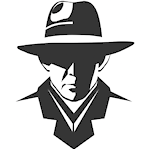About
Film noir is the French label for the “black film” genre peaking in 1944-1955. Its origins are the detective novels of Dashiell Hammett 1929-34 (Sam Spade played by Humphrey Bogart in The Maltese Falcon in 1941) and Raymond Chandler 1933-43 (Philip Marlowe played by Humphrey Bogart in The Big Sleep in 1946) and the femme fatale novels of James Cain 1934-42 (Phyllis Dietrichson played by Barbara Stanwyck in Double Indemnity in 1944). Noir has influenced films to the present day, such as the crime thrillers of Don Siegel (Dirty Harry in 1971), gritty sci-fi of Ridley Scott (Blade Runner in 1982), predatory femmes of Adrian Lyne (Fatal Attraction in 1987), and hardboiled cops of Curtis Hanson (L.A. Confidential in 1997).
The historical setting is the contemporary world that has been corrupted and lost its moral certainty. The prevailing cynicism of characters reflects the reality of the atomic bomb, Cold War, totalitarianism, propaganda, Hollywood blacklist, and corrupting power of the government and press. World War II fragmented men and caused them to feel adrift, insecure, and alienated, a feeling of having “gone soft” and lacking the power to control their lives. The liberal movement was in crisis due to powerful forces of communism and materialism, causing a loss of faith in progress and man’s innate goodness.
The protagonist is a loner, introverted, troubled, hardboiled, and pessimistic. He is not the conventional film hero, confident/exceptional/sure, but rather average and conventional, often is a war veteran or detective, and is defined by his ability to survive and restore normality.
The seeker-hero is on a quest in the noir world. The Hero is repeatedly tested, interrogated, attacked, persecuted, and will emerge safely uncorrupted, firm, or to be killed. However, things are not what they seem, people change identities, and the plot has unforeseen twists and turns.
The noir world can be external or internal. The external world is usually the dark, mean streets of the big city, often Los Angeles with its beaches, apartments, and palm-lined lanes. On the other hand, it could be the nightclub/cafe/police station haunts of the underworld/police/detective. The Hero’s mind is the inner world’s violence/trauma/nightmares.
The antagonist is a femme fatale, a dangerous female who lures/tempts/seduces the Hero. She is glamorous with dark lips and long flowing hair. However, she usually already possesses another man, a wealthy older husband. He is proprietal toward his wife, representing an oedipal complex by the outsider seeking to destroy the influential father figure to possess the woman.
The opposite of the femme fatale is the domestic woman, a wife or girlfriend associated with home/nurturing/rehabilitation.
The voice-over is a subjective/confessional narration telling the story out of a need to confess/purify/cleanse his conscience. The narration personalizes the experience, like a first-person novel.
The visual style of noir is the hard/undiffused look of the tabloid newspaper with cluttered/claustrophobic/dark interiors framed or restricted by the camera frame. There are many night scenes, off-angle and deep focus camera shots, Stark chiaroscuro, low-key lighting, and bleak/fatalistic overtones of despair and madness. With “heightened” expressionistic scenes with distorted/nightmarish/grotesque/exaggerated.
The iconography of noir uses dark sidewalks, rain-drenched streets, flashing neon signs, fairgrounds, and carnivals (associated with madness in German expressionism). The city as villain/dangerous/hostile, the border town or the casino, and imagery of water and alcohol represent merging and release rather than fragmentation and blockage. In addition, media icons are frequent: the telephone (“a metaphor of desire” to overcome limitations and alienation and connect with others), voice recorders, and newspapers.
Community Guidelines
Please respect the following community guidelines to maintain an enjoyable environment:
- Keep conversation respectful, without personal attacks
- Don’t blow up other members’ feeds. If someone isn’t responding to you, let it be
- No pornography
- Keep out behavior that could be seen as trolling/spamming
- Relax, be yourself, and enjoy
